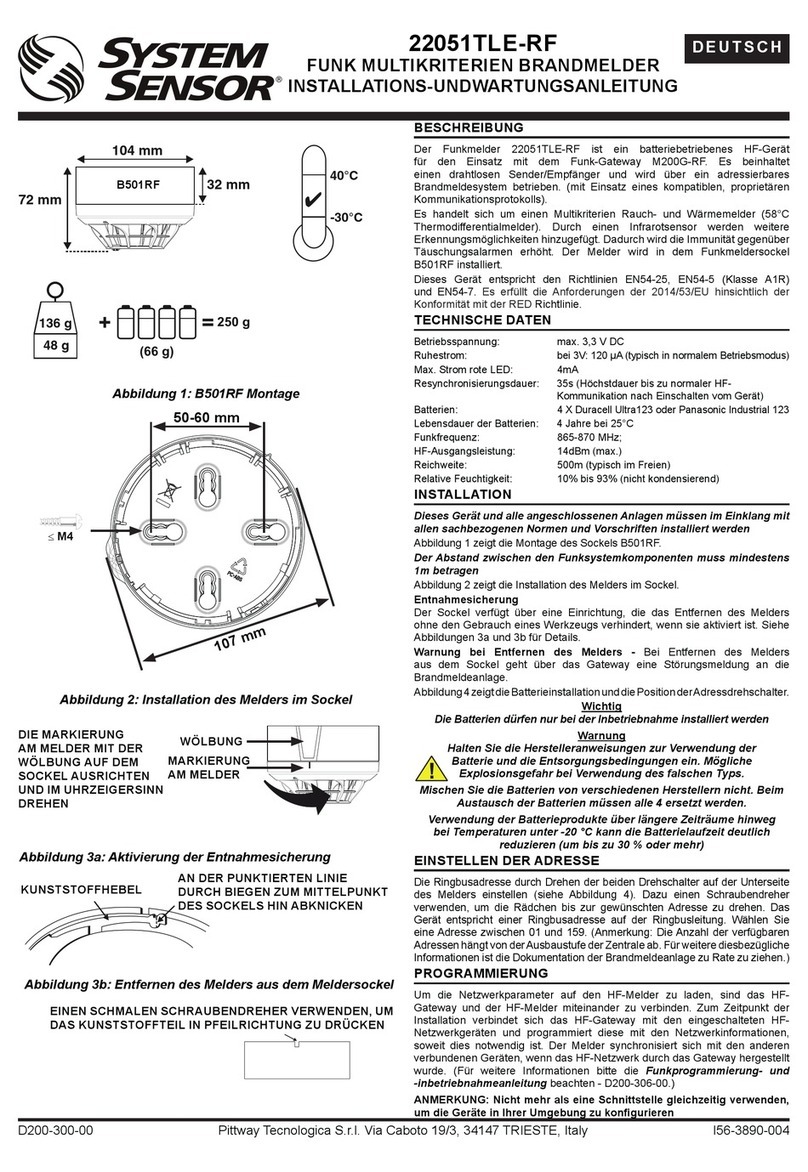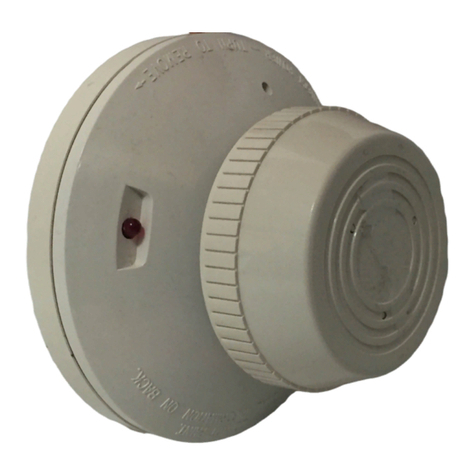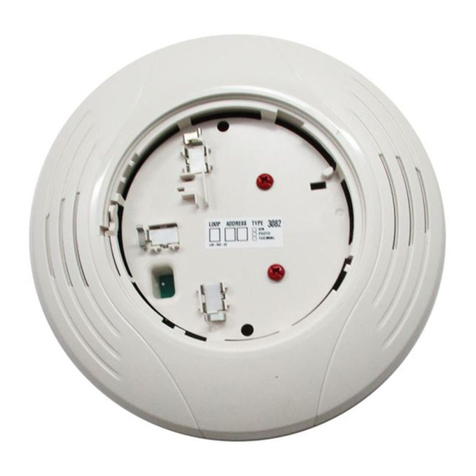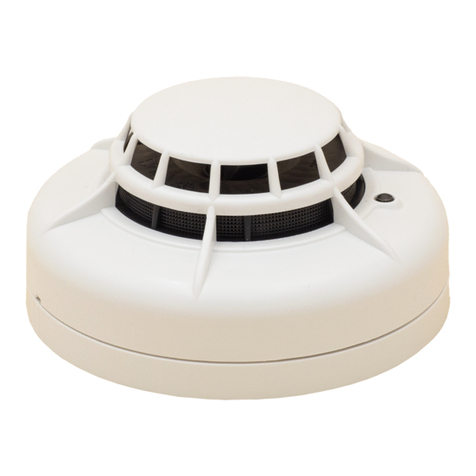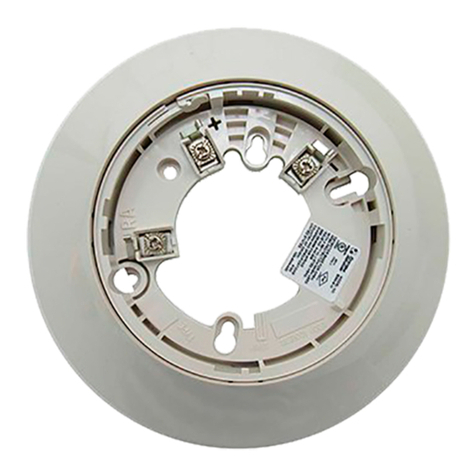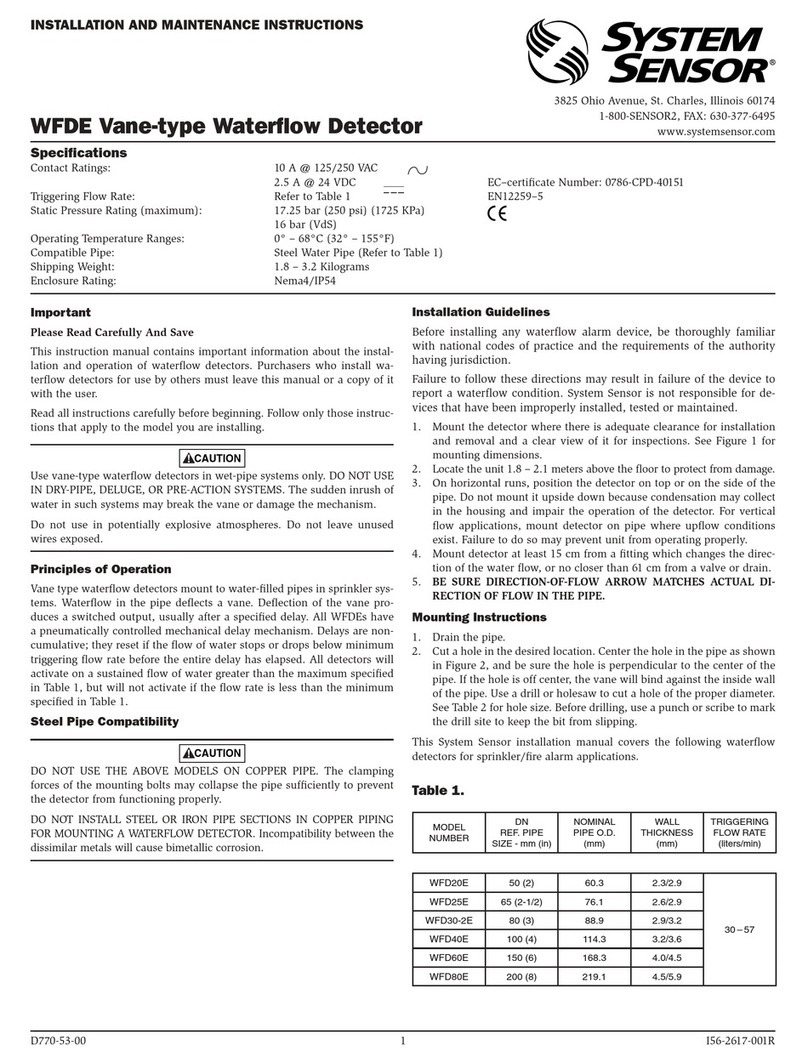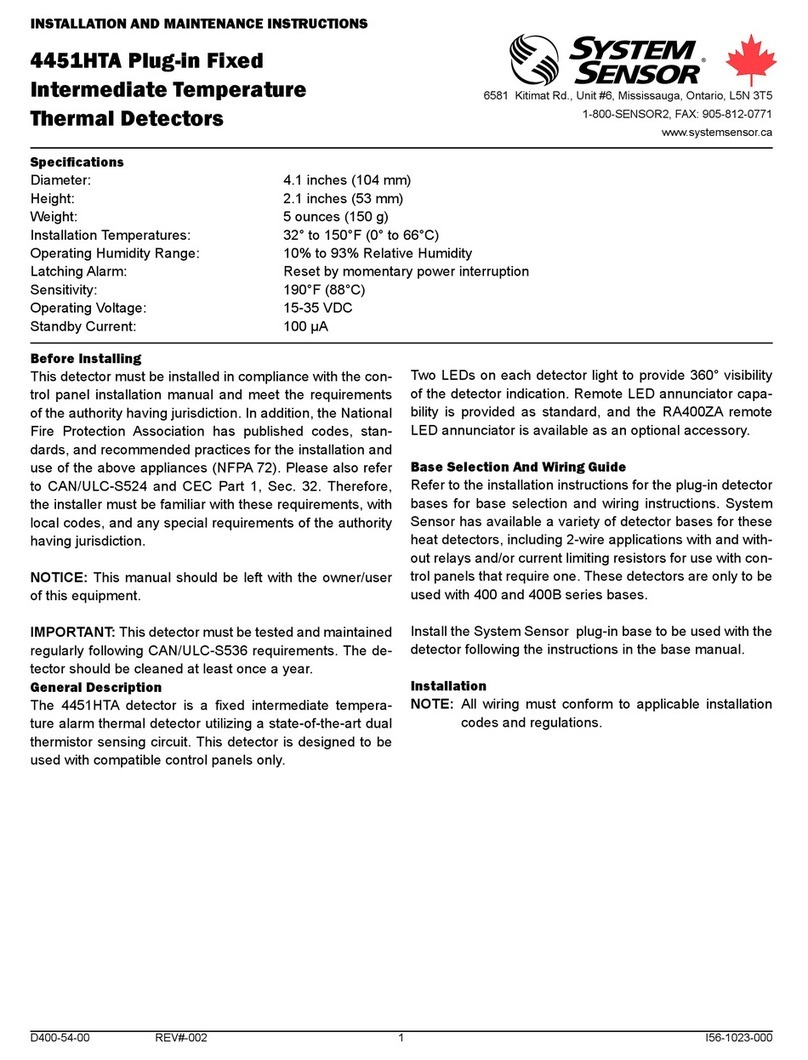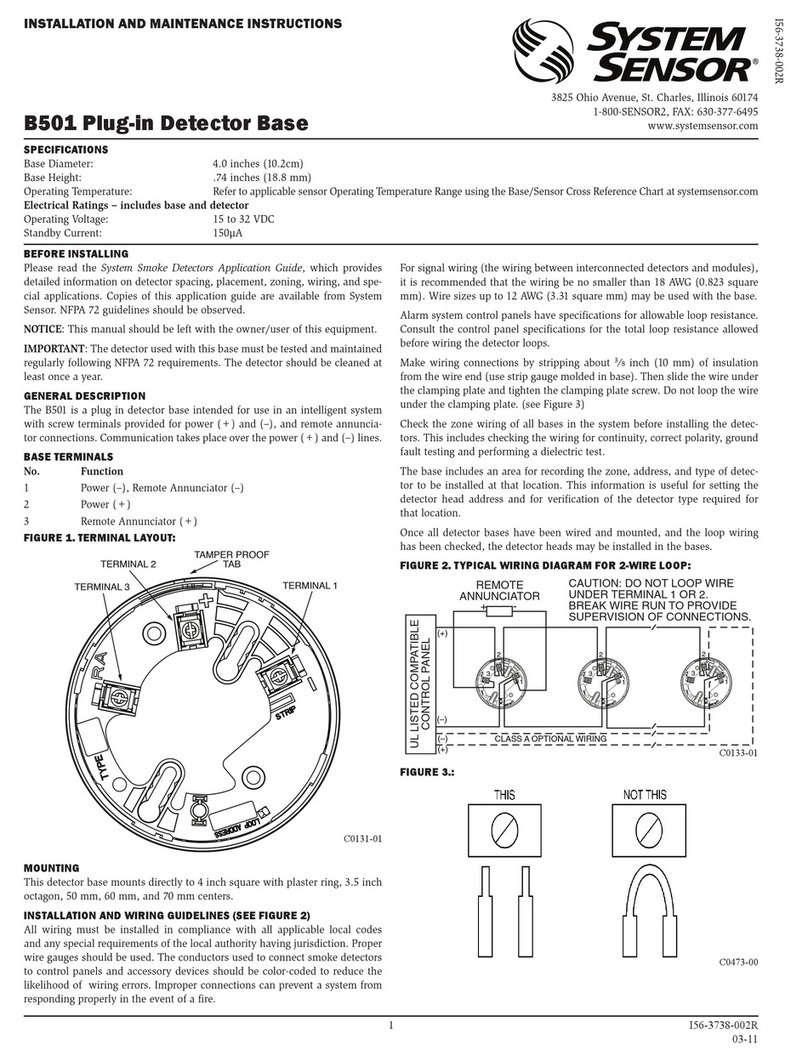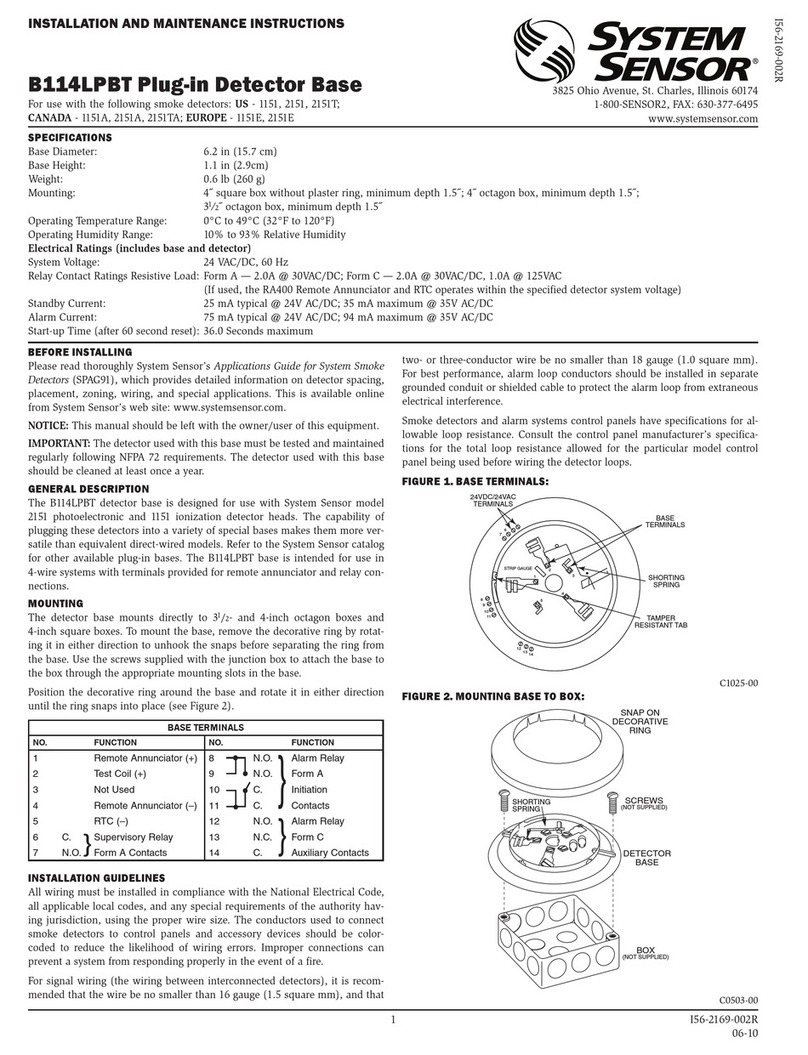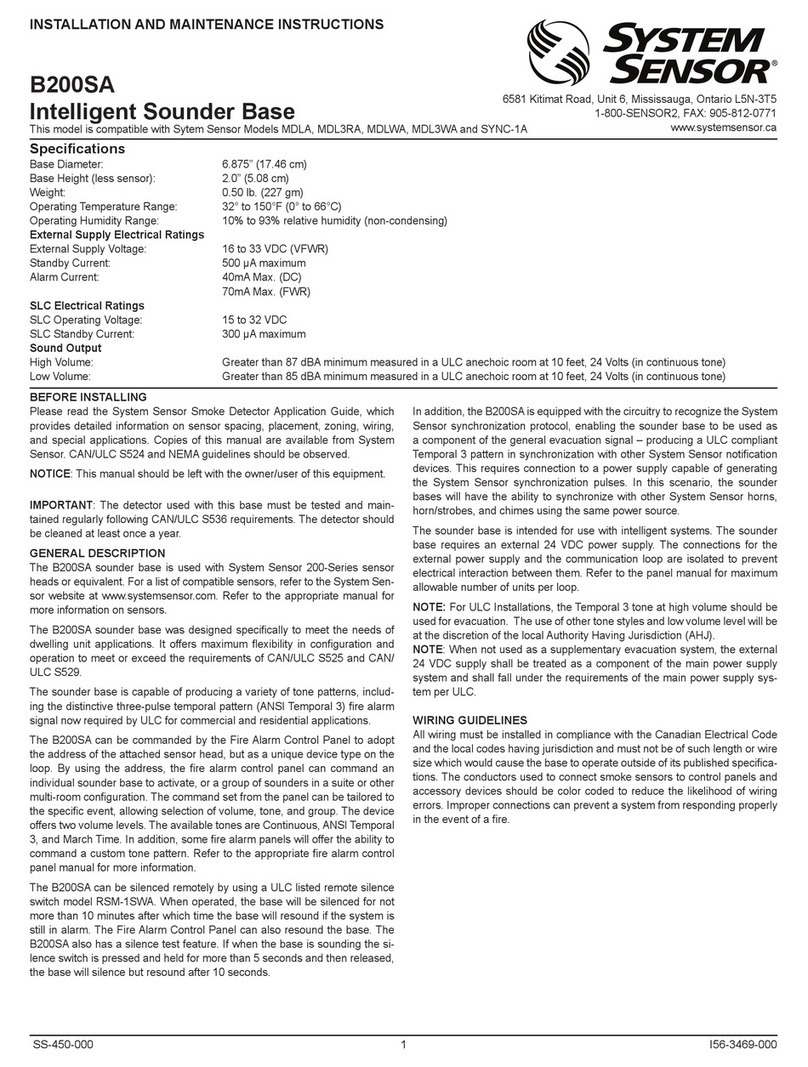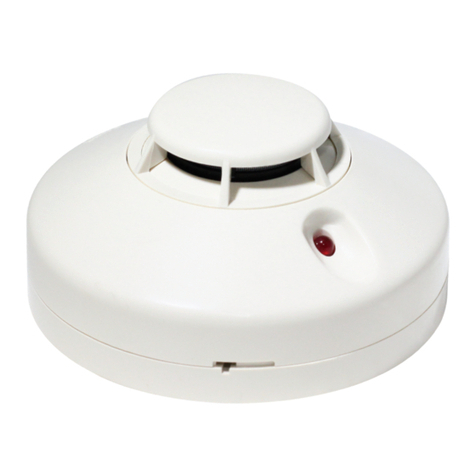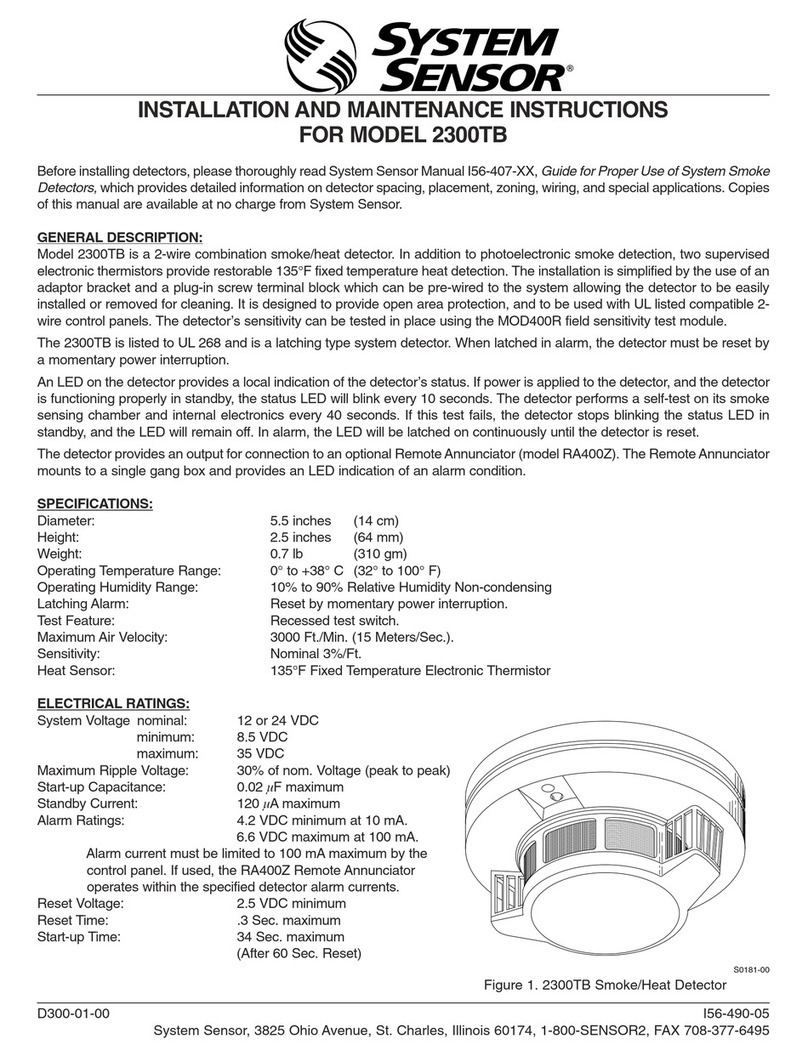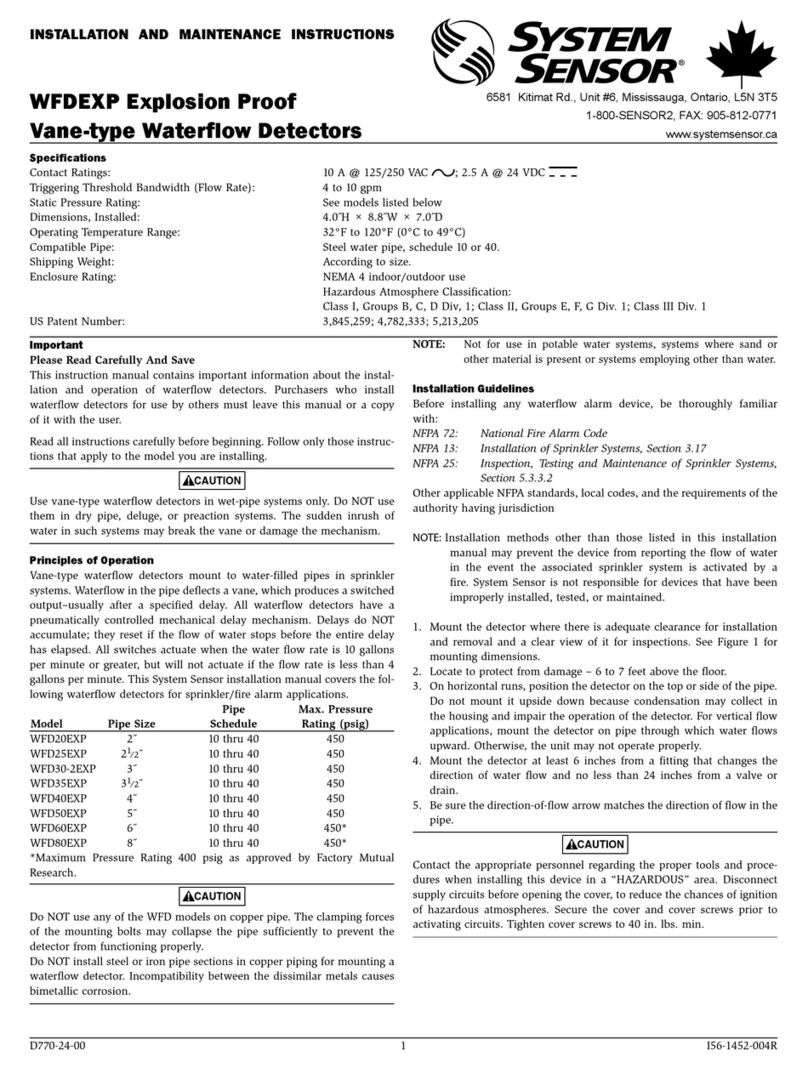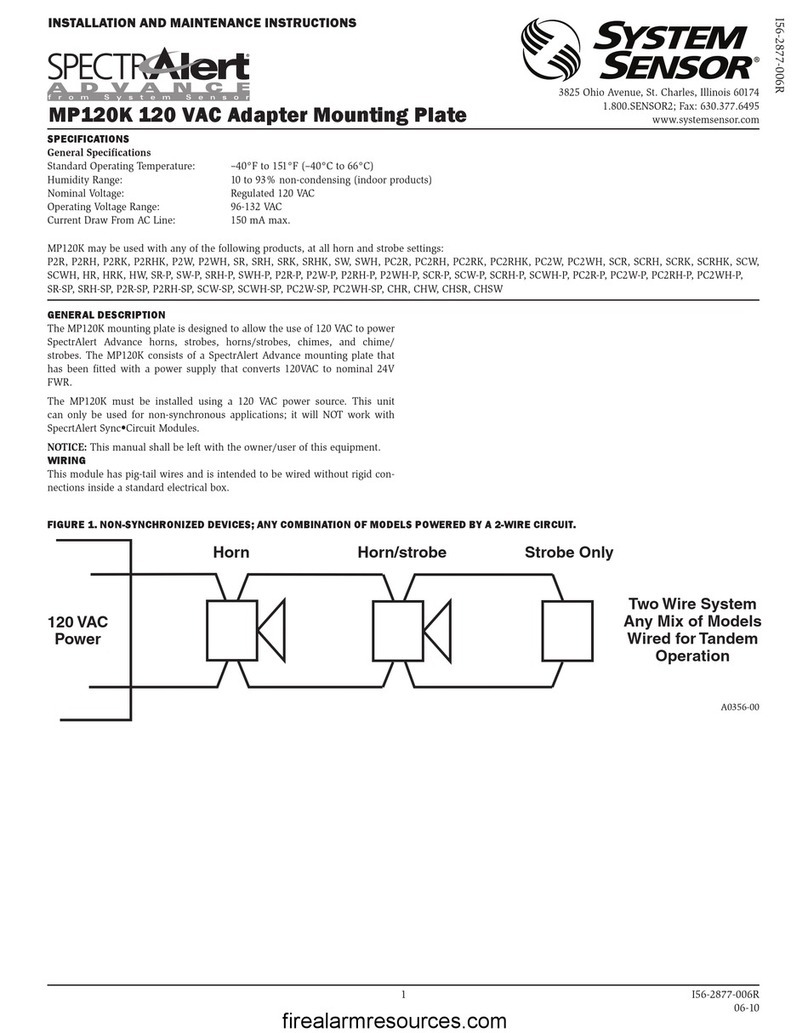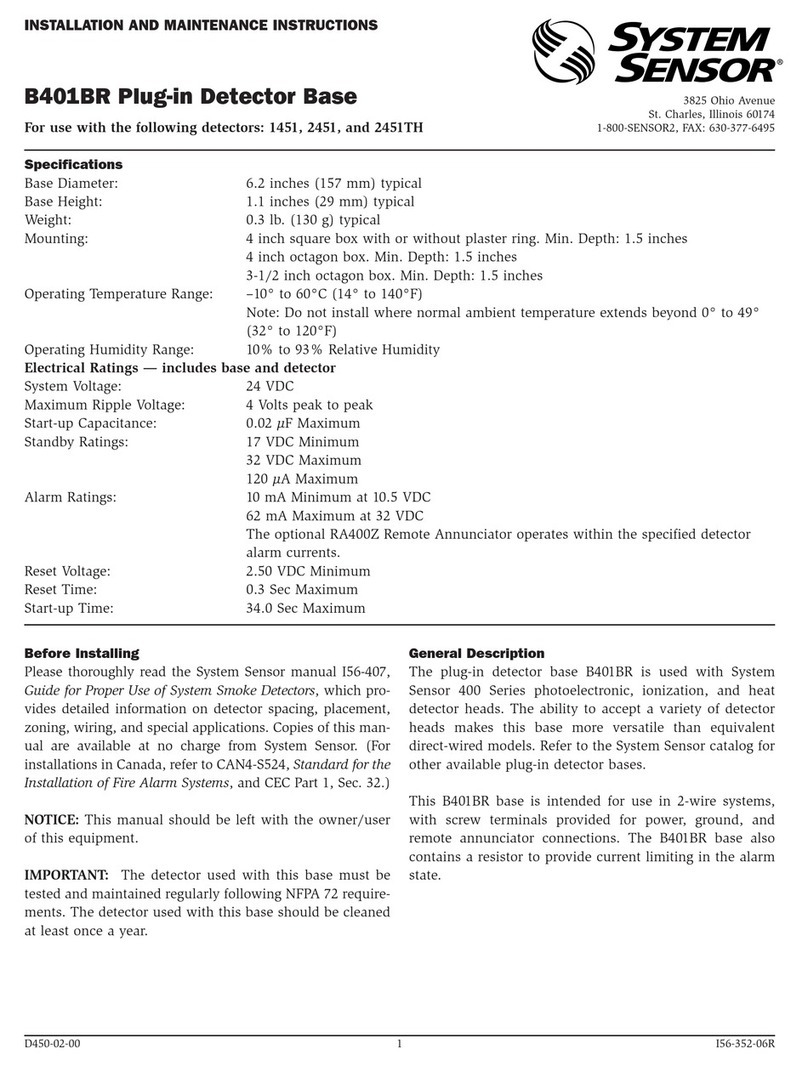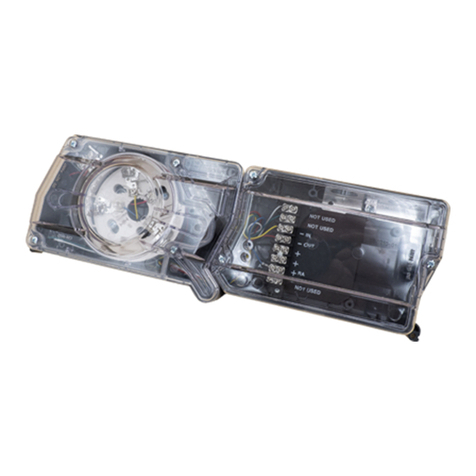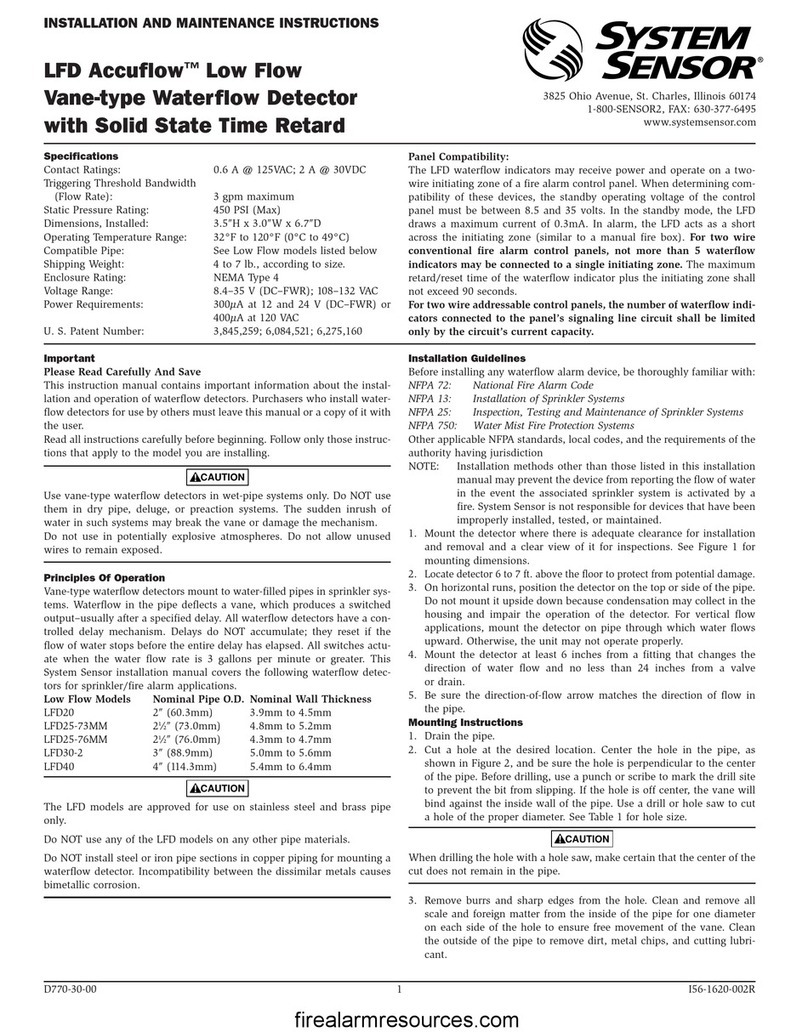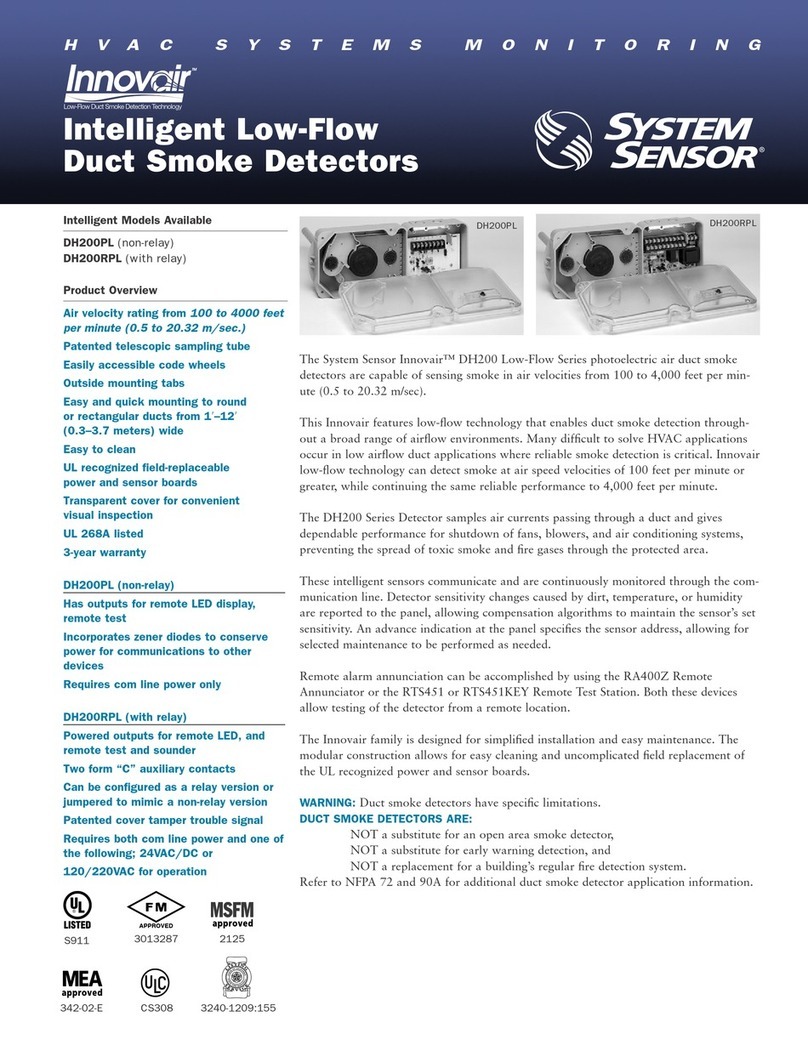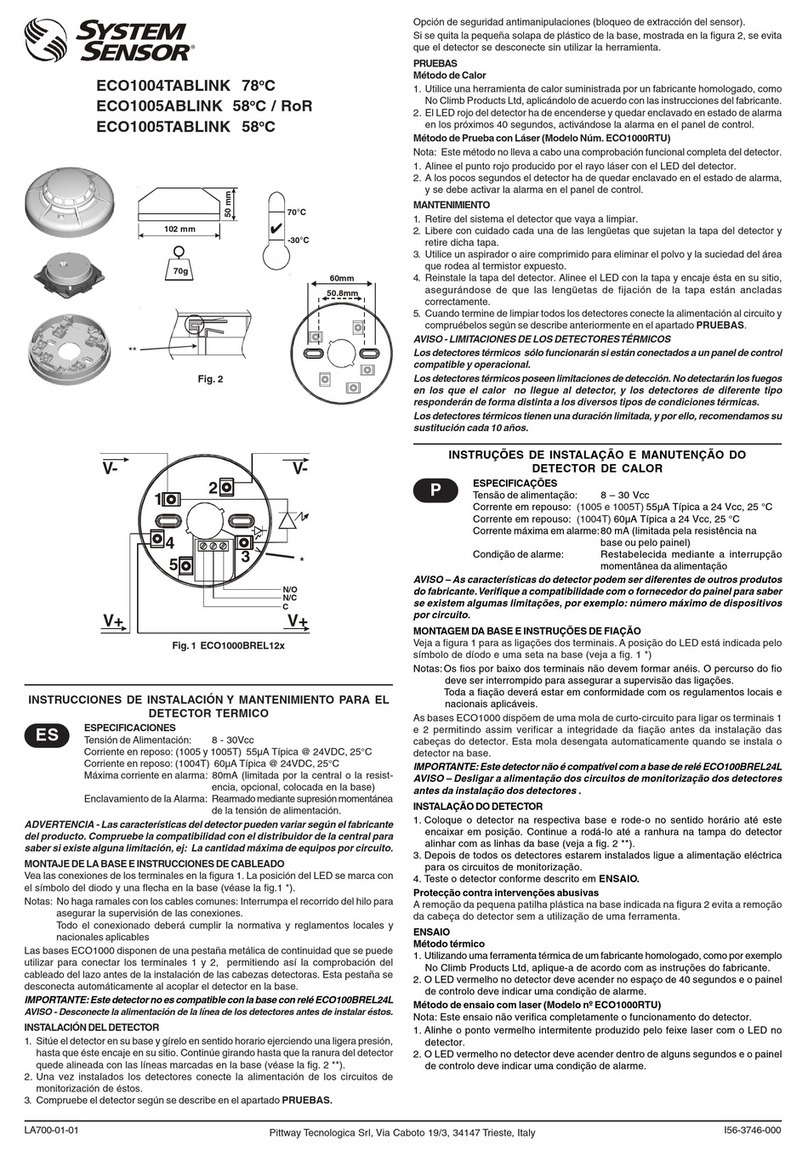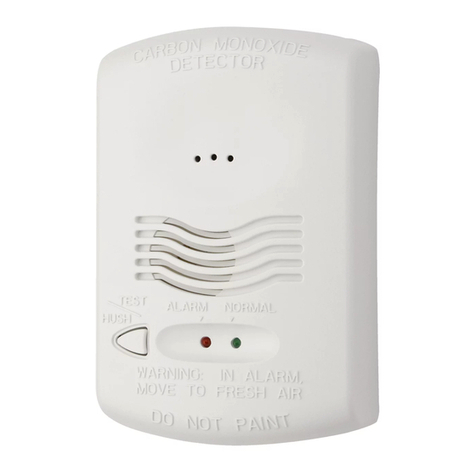D150-05-00 4 I56-594-03R
©2001 System Sensor
System Sensor warrants its enclosed smoke detector base to be free from
defects in materials and workmanship under normal use and service for a
period of three years from date of manufacture. System Sensor makes no
other express warranty for this smoke detector base. No agent, represen-
tative, dealer, or employee of the Company has the authority to increase
or alter the obligations or limitations of this Warranty. The Company’s
obligation of this Warranty shall be limited to the repair or replacement
of any part of the smoke detector base which is found to be defective in
materials or workmanship under normal use and service during the three
year period commencing with the date of manufacture. After phoning
System Sensor’s toll free number 800-SENSOR2 (736-7672) for a Return
Authorization number, send defective units postage prepaid to: System
Sensor, Repair Department, RA #__________, 3825 Ohio Avenue, St.
The smoke detector used with this base is designed to activate and initi-
ate emergency action, but will do so only when it is used in conjunction
with an authorized fire alarm system. This detector must be installed in
accordance with NFPA standard 72.
Smoke detectors will not work without power. AC or DC powered
smoke detectors will not work if the power supply is cut off.
Smoke detectors will not sense fires which start where smoke does
not reach the detectors. Smoldering fires typically do not generate a lot
of heat which is needed to drive the smoke up to the ceiling where the
smoke detector is usually located. For this reason, there may be large
delays in detecting a smoldering fire with either an ionization type detec-
tor or a photoelectric type detector. Either one of them may alarm only
after flaming has initiated which will generate the heat needed to drive
the smoke to the ceiling.
Smoke from fires in chimneys, in walls, on roofs or on the other side of a
closed door(s) may not reach the smoke detector and alarm it. A detector
cannot detect a fire developing on another level of a building quickly or
at all. For these reasons, detectors shall be located on every level and in
every bedroom within a building.
Smoke detectors have sensing limitations, too. Ionization detectors
and photoelectric detectors are required to pass fire tests of the flaming
and smoldering type. This is to ensure that both can detect a wide range
of types of fires. Ionization detectors offer a broad range of fire sensing
capability but they are somewhat better at detecting fast flaming fires than
slow smoldering fires. Photoelectric detectors sense smoldering fires bet-
ter than flaming fires which have little, if any, visible smoke. Because fires
develop in different ways and are often unpredictable in their growth, nei-
ther type of detector is always best, and a given detector may not always
provide early warning of a specific type of fire.
In general, detectors cannot be expected to provide warnings for fires
resulting from inadequate fire protection practices, violent explosions,
escaping gases which ignite, improper storage of flammable liquids like
cleaning solvents which ignite, other similar safety hazards, arson, smok-
ing in bed, children playing with matches or lighters, etc. Smoke detectors
used in high air velocity conditions may have a delay in alarm due to
dilution of smoke densities created by frequent and rapid air exchanges.
Additionally, high air velocity environments may create increased dust
contamination, demanding more frequent maintenance.
Smoke detectors cannot last forever. Smoke detectors contain electronic
parts. Even though smoke detectors are made to last over 10 years, any
part can fail at any time. Therefore, smoke detectors shall be replaced after
being in service for 10 years. The smoke detector system that this detec-
tor is used in must be tested regularly per NFPA 72. This smoke detector
should be cleaned regularly per NFPA 72 or at least once a year.
The Limitations of Property Protection Smoke Detectors
D150-05-00 1 I56-594-03R
B110LP Plug-in Detector Base
For use with the following smoke detectors:
IN US: 1151, 2151
IN CANADA: 1151A, 2151A
IN EUROPE: 1151E, 2151E
INSTALLATION AND MAINTENANCE INSTRUCTIONS
3825 Ohio Avenue, St. Charles, Illinois 60174
1-800-SENSOR2, FAX: 630-377-6495
www.systemsensor.com
Before Installing
Please thoroughly read the System Sensor manual I56-407,
Guide for Proper Use of System Smoke Detectors, which
provides detailed information on detector spacing, place-
ment, zoning, wiring, and special applications. Copies of
this manual are available at no charge from System Sensor.
(For installation in Canada, please refer to CAN/ULC-S524,
Standard for the Installation of Fire Alarm Systems and CEC
Part 1, Sec. 32.)
NOTICE: This manual should be left with the owner/user
of this equipment.
IMPORTANT: The detector used with this base must be
tested and maintained regularly following NFPA 72 require-
ments. The detector used with this base should be cleaned
at least once a year.
Specifications
Base Diameter: 6.2 inches (157 mm)
Base Height: 0.95 inches (24 mm)
Weight: 0.3 lb. (137 g)
Mounting: 4-inch square box with or without plaster ring. Min. depth–1.5 inches
3-1/2-inch octagon box. Min. depth–1.5 inches
Operating Temperature Range: 0° to 49°C (32° to 120°F)
Operating Humidity Range: 10% to 93% Relative Humidity, Noncondensing
Electrical Ratings - includes base and detector
System Voltage: 12/24 VDC
Maximum Ripple Voltage: 4 Volts peak-to-peak
Start-up Capacitance: 0.02 µF Maximum
Standby Ratings: 8.5 VDC Minimum
35 VDC Maximum
120 µA Maximum
Alarm Ratings: 4.2 VDC Minimum at 10 mA
6.6 VDC Maximum at 100 mA
(Alarm current must be limited to 100 mA (130 mA for models 1151 and 2151) by the
control panel. If it is used, the RA400Z Remote Annunciator operates within the specified
detector alarm currents.)
Reset Voltage: 2.5 VDC Minimum
Reset Time: 0.3 Seconds Minimum
Start-up Time: 34.0 Seconds Maximum
General Description
The Model B110LP detector base is designed for use with
System Sensor models 2151 photoelectronic and 1151 ion-
ization detector heads. This two-wire base is equipped with
screw terminals for the connection of power, ground, and
an optional remote annunciator.
Mounting
The detector base mounts directly to 3-1/2 inch and 4-inch
octagon boxes and 4-inch square boxes, with or without
plaster rings. To mount the base, remove the decorative
ring by rotating it in either direction to unhook the snaps
before separating the ring from the base. Use the screws
supplied with the junction box to attach the base to the
box through the appropriate slots in the base (see Figure
1). Position the decorative ring around the base and rotate
it in either direction until the ring snaps into place.
Three-Year Limited Warranty
Charles, IL 60174. Please include a note describing the malfunction and
suspected cause of failure. The Company shall not be obligated to repair
or replace units which are found to be defective because of damage,
unreasonable use, modifications, or alterations occurring after the date
of manufacture. In no case shall the Company be liable for any conse-
quential or incidental damages for breach of this or any other Warranty,
expressed or implied whatsoever, even if the loss or damage is caused by
the Company’s negligence or fault. Some states do not allow the exclu-
sion or limitation of incidental or consequential damages, so the above
limitation or exclusion may not apply to you. This Warranty gives you
specific legal rights, and you may also have other rights which vary from
state to state.
I56-594-03R
